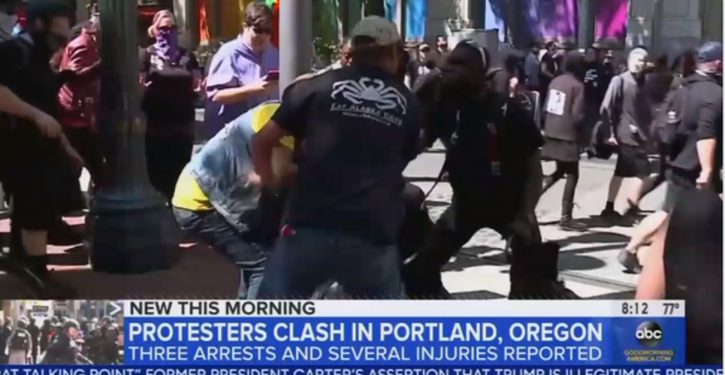
An Antifa mob viciously attacked journalist Andy Ngo on Saturday at a Portland rally. They assaulted him with fists and milkshakes, sending him to the emergency room. Ngo is a photojournalist and editor at conservative-leaning Quillette.
As Reason Magazine’s Robby Soave observes:
The assailants wore black clothing and masks, and were engaged in a counter-protest against several right-wing groups, including the Proud Boys. Ngo is a well-known chronicler of antifa activity, and has criticized their illiberal tactics on Fox News. He attended the protest in this capacity—as a journalist, covering a notable public event.
The assailants also stole Ngo’s camera equipment. As Soave notes, “video footage recorded by another journalist, The Oregonian‘s Jim Ryan, clearly shows an antifa activist punching Ngo in the face. Others throw milkshakes at him.”
Portland police say milkshakes thrown by the antifa activists on Saturday contained quick-dry cement, which poses health hazards. Uncured cement is highly alkaline and can cause burns. It can also blind if it gets in the eyes.
As Soave observes, an “antifa mob beat up a journalist…who posed no physical threat to them and was only there to document their activities—on a public street. This is indefensible, and yet there are tons of progressive-leaning people currently defending it, or at the very least rationalizing and making light of it.”
Progressives in the media will no doubt continue to minimize or excuse this violence, because it was aimed at a journalist for a conservative-leaning publication. But they shouldn’t, because such violence can happen to them, too. Being progressive doesn’t necessarily save people from Antifa’s wrath. In 2018, a progressive Washington Post columnist had her cell-phone knocked out of her hand by Antifa while covering a rally, and was told to F* herself. Antifa did this to her even though she shares Antifa’s antipathy to conservatives, and even though the Washington Post’s designated “media columnist,” Margaret Sullivan, had defended Antifa in a 2017 column.
Antifa also attacks people overseas, as part of its “struggle against capitalism,” notes Fredrik Segerfeldt. He describes an Antifa attack in Sweden on a supporter of free markets:
It is a cold and dark January night in the Swedish town of Eskilstuna. Fredrik Nyqvist and a friend are walking home from the founding meeting of the local section of the minuscule Libertarian Party.
Suddenly, four men in black clothes and facemasks show up, knocking the two unconscious. One of the offenders later bragged about jumping on Fredrik’s head, causing injuries that kept him hospitalized for days.
The two libertarians had no way of identifying the perpetrators and assumed it was just a regular criminal incident. They could not know they had just become victims of political terrorism. But they would soon find out.
At his home a couple of days later, a third party member received a note from a group claiming responsibility for the attack, and was warned:
We hereby give you a chance to terminate all political activities. Failing to do so, you may be the next one to be physically reminded of the consequences of pursuing anti-working class policies.
Antifa attacks such people because their “beliefs in the rule of law, property rights, and markets are anathema” to Antifa.
As CNS News notes, “Antifa thugs have repeatedly beaten or threatened journalists and regular citizens on the street who dare to capture them on tape.”
But newspapers like the Washington Post have foolishly minimized Antifa’s violence and extremism. They claim its violence has been given too much media coverage, such as the “club-wielding protesters shown endlessly on TV.” In a column by Margaret Sullivan, The Post complained that Antifa members had been wrongly stereotyped as violent thugs, by those who believe that Antifa members are “the left-wing equivalent of neo-Nazis.” Instead of focusing on Antifa’s violence, the press should “explain the group’s ideology, tactics or goals.” She argued that the media should not dwell on on violent acts committed by Antifa members, because that would play into a conservative meme about violent leftists. She also said Antifa deserves “credit” for taking to the streets.
Sullivan defended Dartmouth Professor Mark Bray, who said Antifa’s violence is a “legitimate response” to opposing views on the Right. She lamented the fact that Bray was “publicly” criticized “by his university president” for defending its violent activities.
Washington Post columnists like Sullivan are not much troubled by Antifa’s violence, especially when it is aimed at ordinary citizens, rather than the media. Journalists yawned when an Antifa goon was given probation by a liberal judge after attacking seven people from behind. The Antifa thug hit his victims so hard with a heavy metal bike lock that one victim had a piece of his “helmet broken off,” and another suffered a “head laceration that required five staples to fix.”
As Jerome Woehrle has noted:
Sullivan’s downplaying of violent thuggery is worrying, because she is representative of the Post and the liberal media. She is the epitome of the journalistic establishment as the Post’s designated “media columnist.” Before joining The Post, she was the New York Times public editor and previously the chief editor of the Buffalo News. She was a member of the Pulitzer Prize board from 2011 to 2012, and was twice elected as a director of the American Society of Newspaper Editors, where she led the First Amendment committee.
Antifa claims it is fighting “fascism.” But as Anthony L. Fisher observed in the Daily Beast, “some victims of antifa violence have included people that only someone who sees Nazis on the insides of their eyelids could define as fascistic: journalists, photographers, and people of color.” Andy Ngo, who was attacked on Saturday, is a gay Vietnamese-American. The Weekly Standard earlier chronicled Antifa’s attack on a half-Japanese man who was holding a free speech rally.
Supporting free markets and capitalism gets people labeled as “fascist” by antifa. It targeted the president of the University of Minnesota’s College Republican chapter, Madison Faupel. Her experience is chronicled in the article, “A Campus Conservative’s Year of Facing Anger, Doxing, and Intimidation.” The “far-left militant group Antifa targeted her for promoting capitalism on campus, posting online her address, phone number, parent’s address, parent’s phone number, a photo of her, and a reference to her as an alt-right Nazi.”
As Fisher notes, Professor Mark Bray’s pro-Antifa book has made him “an in-demand media presence.” This is true in spite of — or perhaps because of — the fact that “Bray eschews any pretense of objectivity,” and his book “contains unabashed advocacy” for antifa, and “glorification of antifa violence.”
Describing Antifa’s actions on Inauguration Day in 2017, Bray writes glowingly of “the most iconic moment of the day … when a limousine was set ablaze.” As Fisher observes:
Bray neglects to mention the immolated limousine was occupied by a Latino driver who suffered minor injuries in the attack, and the vehicle was owned by a Muslim immigrant, who asserts he was later harassed by individuals who mistook him for a Trump supporter.



